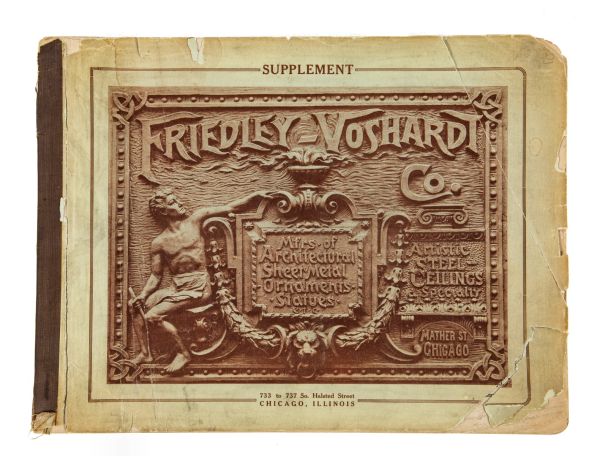rare early 20th century original profusely illustrated chicago-based friedley-voshardt ornamental metal catalog
SOLD
Out of stock
SKU
UR-34204-22
three similar catalogs dating to same era available.
another important period trade catalog i'm in the midst of digitizing. i have three friedley-voshardt company catalogs, some advertising cards and brochures, and copper ornament they fabricated in their factories. they did both residential and commercial buildings.
some time ago, i discovered that they created the "sullivanesque" tin ceiling stock pattern, which ended up being a popular option for use in saloons, pubs, or cafes around chicago during the early 20th century.
friedley-voshardt company's main offices were once at 733-737 south halsted and the factory resided at 761-771 mather street. a chicago tribune blurb from 1893 announces the company would erect a 3-story, 50 x 150 light manufacturing building at mather & halsted, after plans of d.h. laponte and at a cost of $16,000. records indicate they also seem to have occupied 1501 w. congress street during the early 20th century.
together, friedley and voshardt manufactured architectural sheet metal during the late 19th century into the late 1920's, after which time both men passed away. catalogs display an extensive assortment of figurative and decorative statues, building ornament, brass "fixture" parts or fittings, and interior tin metal ceilings. a number of patents were taken out in the names of both men, for design-work and devices associated with metalworking.
the company was purportedly founded in 1875 as "friedley & voshardt", and the first edition of its catalog didn’t appear for another 14 years. their overall manufacturing process consisted of swaging metal in sections by the use of metal dies (made from plaster casts, those in turn made from the model). the sections would be shaped and soldered and/or riveted together in such a manner as to make joints seamless or "invisible."
courtesy of bldg. 51 archive.
WORDLWIDE SHIPPING
If required, please contact an Urban Remains sales associate.
NEW PRODUCTS DAILY
Check back daily as we are constantly adding new products.
PREMIUM SUPPORT
We're here to help answer any question. Contact us anytime!
SALES & PROMOTIONS
Join our newsletter to get the latest information

























